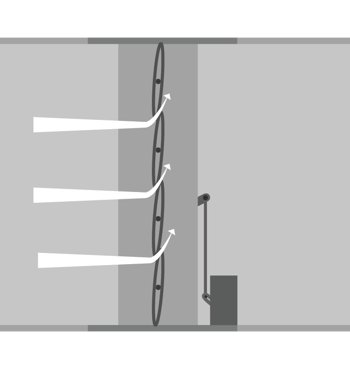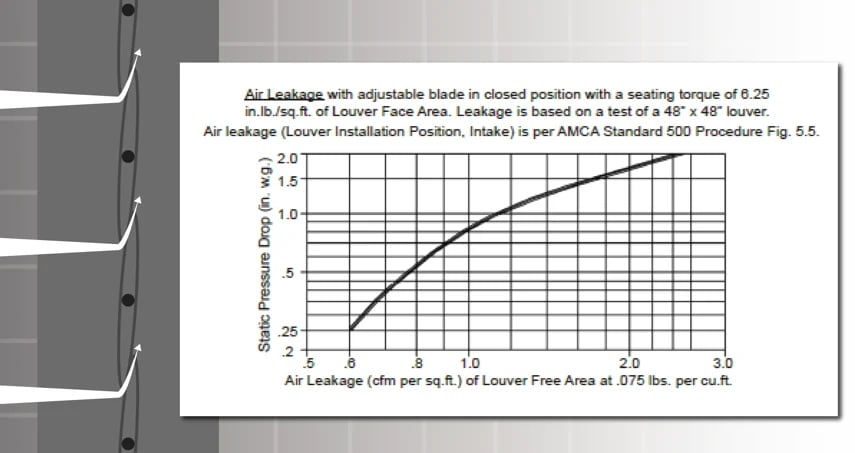In this article, we discuss how air leakage affects air performance. Learn what adjustable louvers and control dampers do to minimize this performance killer.
Air Leakage and Performance
Air leakage is those wisps of air that get through the closed blades of dampers and adjustable louvers. There will always be some air leakage, since no damper or louver is airtight, but too much leakage can cause trouble. If left unchecked, this leakage can hinder performance and cause an excess strain on your system. With life safety dampers, leakage is dangerous.
The best way to manage air leakage is to minimize it as much as possible.

Pictured above - An illustration of air leaking through the blades of a closed control damper.
Why is air leakage bad?
For control dampers, excessive air leakage will reduce system efficiency at key points in the ductwork. Air flow needs static pressure to move through the system. Leaky control dampers will allow air through and cause an unnecessary drop in static pressure. This drop will translate to weaker airflow in other parts of the ductwork.
Starting a new project? Contact Arrow United Industries about our line of control dampers. Let's work together to meet your requirements!
Your system fans will need to move faster to make up the difference, which wastes electrical power to pull the same amount of air. This also puts more unnecessary strain on vital system components, which will require more frequent servicing. These issues waste time, money, and resources to do the same task. The cost of leaky control dampers adds up. Inefficient systems always cost more.

Louvers and dampers can be tested for air leakage in accordance with AMCA Standard 500. Models that receive this testing will have an AMCA Ratings Seals. The testing data will be present on the submittal document.
For adjustable louvers, the problem starts at the front of the line. A louver with adjustable blades can act as a control damper for the intake and exhaust points of the system. These louvers will close their blades at the opening of the system to prevent air from moving through until it's needed. Their closure should be tight to avoid air leakage.
The same problems can occur when air leaks through a closed adjustable louver. System fans must work harder to push air through the ductwork. Experts will often recommend installing a control damper behind the louver, but a second set of blades may not fix the issue. You should look for a tight-closing adjustable louver.
Prevent leakage with blade and jamb seals
Dampers and adjustable louvers will have seals installed along the edges of their blades and within the jambs of their frames. Blade seals prevent air from passing through the space between the blades, while jamb seals prevent leakage in the areas between the blades and the jamb. Together, blade and jamb seals create a tight blade closure with minimal space for air to escape.
.jpg?width=600&height=400&name=Backdraft%20Blade%20Seal%20(Resize%2c%20HS).jpg)
A close-up of a damper blade seal. These seals will cover the small spaces between blades.
Measuring air leakage and AMCA testing
For each louver and damper passing AMCA's air leakage test, AMCA will issue an air leakage seal, showing that an AMCA-approved laboratory conducted the tests using AMCA testing standards. AMCA seals ensure that the test data presented on the product’s submittal comes from a reliable source. Tested louvers and dampers will also receive a leakage class, a tiered classification that represents an acceptable maximum air leakage.
- Class 1A* – The least amount of air leakage:
- 3 cfm/ft² @ 1 in. w.g.
- Class 1 – Minor Air Leakage:
- 4 cfm/ft² @ 1 in. w.g. or 8 cfm/ft² @ 4 in. w.g.
- Class 2 – Moderate Leakage:
- 10 cfm/ft² @ 1 in. w.g. or 20 cfm/ft² @ 4 in. w.g.
- Class 3 – The Most Amount of Acceptable Air Leakage:
- 20 cfm/ft² @ 1 in. w.g. or 40 cfm/ft² @ 4 in. w.g.
* Class 1A is only tested at 1 in. w.g. of differential pressure.
Always check the product data sheet for the air leakage test data, the leakage classification, and any AMCA ratings seals. These sources can help you make the right decisions when designing an HVAC system.
.webp?width=700&height=268&name=MCDLG%20Blog%20-%20AMCA%20seals%20(Resize).webp) AMCA Ratings Seals show that the product was tested in accordance with AMCA testing standards.
AMCA Ratings Seals show that the product was tested in accordance with AMCA testing standards.
An HVAC system with leaky dampers won't perform at its best. Every bit of air leakage adds up. Too much leakage can kill your air performance. Keep your HVAC system running at peak condition with adjustable louvers, air control dampers, and life safety dampers rated for air leakage.
Are your dampers rated for air leakage? What are other ways to keep your HVAC system efficient? Share your thoughts in the Comments section below. We want to hear from you!
Learn more about dampers with these Newsstand articles:
- The Condenser - A Closer Look at Blade Seals
- Four Ways to Make Efficient Dampers
- The Condenser - Product Spotlight: The 517-518 Series
.png?width=613&height=303&name=MCDLG%20Blog%20-%20Control%20vs%20Balance%202%20(Resize).png)
MCDLG & Continuing Education
Want to know more about air leakage? MCDLG offers a free self-paced course on control dampers, which also covers the tests and ratings for determining AMCA's leakage class.
"An Introduction to Air Control Dampers" covers all the basics of control dampers: what they do, where they go in an HVAC system, the principles that dictate their performance, and guidelines for installing and maintaining your control dampers. Earn continuing education credits at your own pace. Visit the MCDLG Campus Portal today!
.webp?width=91&height=70&name=MCDLG%20Logo%20(Resize).webp)
.webp)






